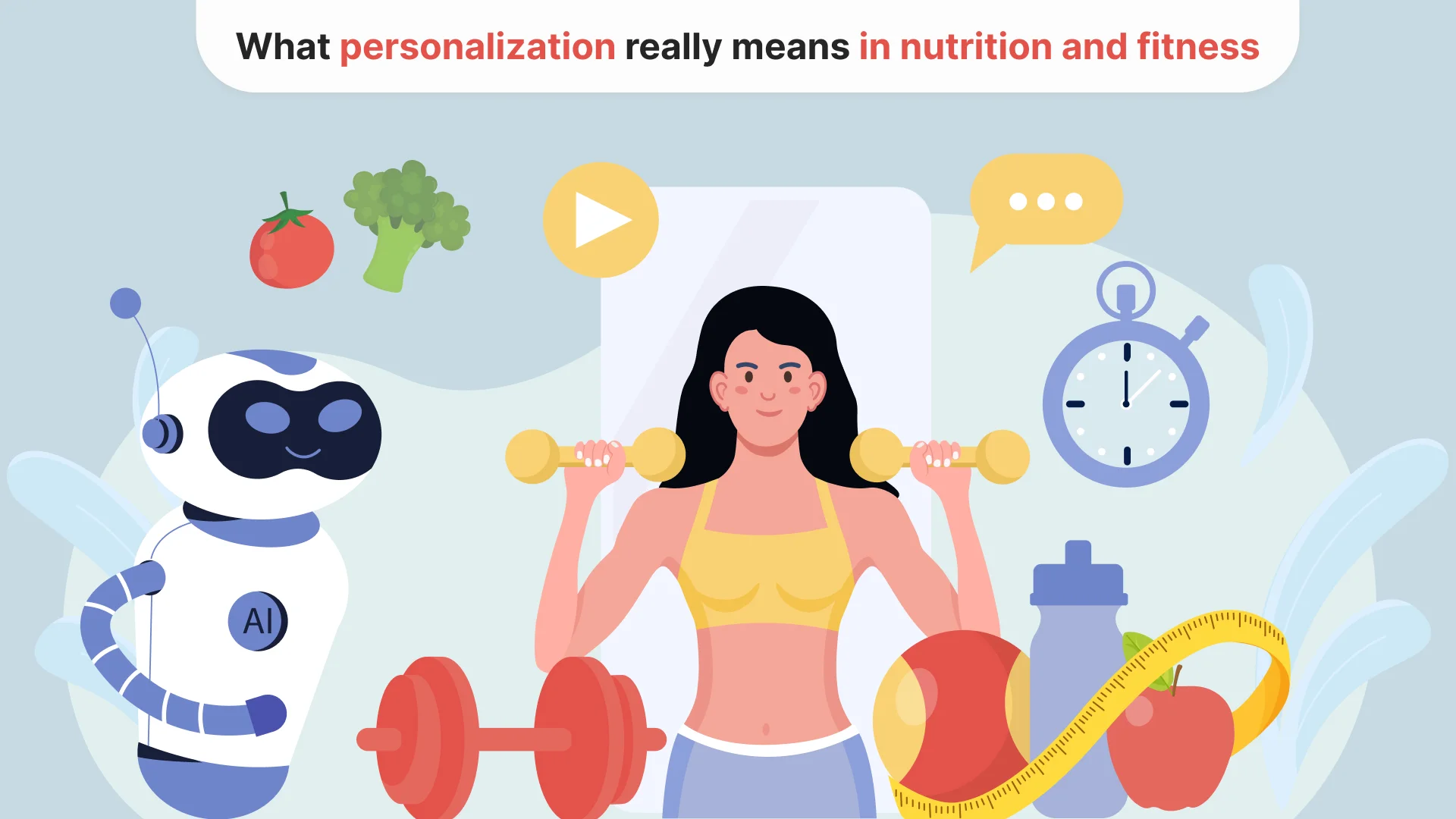

Personalizing Nutrition and Fitness Coaching With AI
When digital fitness and nutrition apps first gained popularity, they promised to revolutionize how we approach wellness: personalized plans, smarter routines, tailored meals. But in 2025, the vast majority of these tools still offer a static experience. You input your height, weight, and goals, and receive a one-size-fits-most plan, sometimes with your name sprinkled in for effect.
Although the wellness apps market is projected to reach $13.02 billion in 2025 and $52.77 billion by 2035, with a CAGR of 15.02% from 2025 to 2035, this surface-level personalization has led to what industry insiders call “template fatigue”.
Meanwhile, AI-powered personalization is being successfully deployed in other industries — from finance to e-commerce to education — to dynamically respond to user behavior, predict needs, and adapt experiences in real-time. So why is wellness still lagging?
The problem isn’t a lack of demand. It's a lack of context.
What Personalization Really Means in Nutrition and Fitness

To move beyond static experiences, we need to redefine what personalization truly means in this domain.
Level 1: Demographic Segmentation
This is where most platforms still operate. Meal and workout plans are generated based on basic demographic inputs: age, gender, weight, and dietary preferences. It’s better than nothing, but not by much.
Level 2: Behavioral Layer
This includes integrating wearables and tracking apps to analyze steps, calorie intake, sleep, and workouts. Some apps (like MyFitnessPal or Fitbit) visualize the data, but rarely use it to inform real-time decision-making.
Level 3: Context-Aware Feedback Loops
At this level, platforms begin responding to how the user actually behaves. If you skipped two workouts this week, your plan adjusts. If your sleep quality is down, training intensity is reduced. Here, AI starts acting as a dynamic co-pilot rather than a static rulebook.
Level 4: Predictive & Adaptive Personalization
This is the frontier. AI models begin to anticipate problems before they happen, predicting when a user is likely to skip a meal, binge late at night, or overtrain. Based on historical data and behavioral signals, the system adapts proactively. Think: “You didn’t sleep well last night — let’s swap your HIIT workout for a mobility session,” or “You tend to snack late after high-stress workdays — here’s a high-fiber option with lower glycemic load.”
In essence, personalization is not about offering a different plan — it’s about offering the right plan at the right time.
When Personalization Fails: Behavioral Patterns, Dropout Risks, and Public Backlash
While AI-powered wellness tools hold enormous promise, personalization — when done poorly — can backfire. Over the past three years, we've seen a wave of dropouts, lawsuits, and public criticism stemming from algorithmic missteps in nutrition and fitness coaching. Behind the glossy UI of many apps lies a dangerous misunderstanding: personalization is not just a technical feature. It’s a relationship, and one that can be easily broken.
Let’s explore three key failure points that highlight what happens when personalization lacks context, transparency, or empathy, and what startups can learn from them.
1. Patterns of Burnout and Disengagement
Even the most sophisticated wellness platforms struggle to retain users if they fail to account for the unpredictability of human behavior. Despite technological advances, many apps still lack what behavioral scientists call forgiveness logic — the ability to recognize disruption and respond with empathy.
In 2022, a team of researchers published an analysis of 120 real-world user reviews across six major AI-powered health and fitness apps. The results revealed a recurring frustration: users felt punished by rigid systems that didn’t adjust when life got messy, whether due to illness, work travel, or mental fatigue.
This kind of experience reflects a broader structural gap: when personalization is reduced to algorithmic strictness, it risks breaking the very trust it was designed to build. AI-driven wellness platforms must move beyond static goal tracking and build systems that understand when and why users deviate — and how to support them through those moments, not punish them.
2. The Danger of Over-Constraining Personalization: The 1,200-Calorie Backlash
Even AI-powered wellness platforms with the best intentions can run into ethical and safety concerns when personalization becomes rigid, or dangerously optimized for results. A striking example is the controversy surrounding one of the most widely used behavior change and weight-loss apps (name withheld to remain neutral and avoid brand-specific attribution in an industry-wide discussion).
In 2022, a popular AI-based app faced mounting public criticism for offering calorie targets as low as 1,200 kcal/day, especially for women, regardless of health status or lifestyle. While the company used an adaptive algorithm to guide users toward weight loss, the underlying logic focused on results, not long-term well-being.
A widely shared investigation revealed the story of a woman with Hashimoto’s thyroiditis, an autoimmune condition affecting metabolism, who was prescribed a 1,200-calorie diet through the app. She reported feeling extreme fatigue, brain fog, and mood disturbances, and ultimately canceled her subscription during the free trial.
As backlash grew from both users and healthcare professionals, the company updated its algorithm to raise the minimum daily calorie recommendation for women to 1,320 kcal, but the damage to trust was already done.
This case underscores a critical lesson: optimization without context can be harmful. An AI model may correctly calculate the caloric deficit required to meet a target weight, but without safeguards for medical history, mental health, or biological diversity, it risks pushing users toward unhealthy, even dangerous, behaviors.
For startups building AI-driven coaching systems, this isn’t just a cautionary tale; it’s a design imperative. Personalization must be anchored in physiology and ethics, not just data patterns.
3. Racial Bias in Wellness Algorithms and Biometric Tools
While AI promises neutrality, its outcomes are only as inclusive as the data it's trained on. In the wellness space, this becomes particularly urgent when algorithms are used to analyze biometrics or offer health advice, because physiological baselines can differ significantly across racial and ethnic groups.
In 2020, a major investigation by The Washington Post revealed that pulse oximeters — widely used to estimate blood oxygen levels — consistently overestimated oxygen saturation in Black patients, due to calibration based primarily on light-skinned individuals. This issue persisted even in FDA-approved devices and had direct implications for health outcomes during COVID-19 (Washington Post, 2025).
Meanwhile, several facial recognition systems embedded in biometric health apps have been shown to underperform on darker skin tones, leading to false readings or user exclusion. MIT Media Lab’s Gender Shades project found that facial analysis algorithms had an error rate of 0.8% for light-skinned men but up to 34.7% for dark-skinned women (Buolamwini & Gebru, 2018).
These aren’t isolated failures — they’re systemic issues rooted in non-diverse training data.
What Startups Should Learn
Challenge | Underlying Issue | Strategic Takeaway |
Emotional disengagement | No adaptation to real-life disruption | Build “forgiveness logic” and emotional adaptability |
Dangerous calorie recommendations | Outcome optimization over a health context | Enforce medical safety boundaries in AI recommendations |
Racial and biometric bias | Non-diverse training data and model calibration gaps | Ensure racial diversity in datasets and validate accuracy across demographics |
Those are just a few examples of the most common issues. In reality, there are so many more examples of failed personalization attempts. Let’s look deeper into possible solutions.
The Infrastructure Layer: Building for True Adaptability, Not Just Automation
Many digital health startups dream of AI-powered personalization. But few are ready for what it takes under the hood. Real personalization, not just cosmetic tweaks or chatbot wrappers, requires a foundational infrastructure that can handle complexity, context, and change.
The biggest mistake founders make? Assuming that once you collect data, personalization just “happens.” In practice, it requires solving five deeply interrelated challenges: data architecture, modeling adaptability, feedback logic, explainability, and compliance.
Let’s break those down.
Fragmented Data = Broken Personalization
Fitness and nutrition decisions don’t live in isolation. They’re influenced by sleep, stress, travel, menstrual cycles, medication, comorbidities, and mood.
Yet most wellness apps operate with siloed datasets. Food logging is disconnected from sleep tracking. Training plans are static, regardless of menstrual phase or recovery metrics. Even when users share data from wearables, it’s rarely fully integrated into decision-making logic.
To build true personalization, you need:
Multimodal data ingestion: food, activity, biometric, behavioral, psychological, contextual.
Time-aware structuring: real-life behavior unfolds over time. Your models need to recognize sequence, change, relapse, and rebound.
Personalization Requires Feedback Loops, Not Static Plans
A “personalized” plan that doesn’t change based on user behavior is not truly personalized — it’s labeled.
Effective systems must include real-time feedback loops that respond to adherence, energy level, stress, and schedule variation. If a user skips three days of workouts or consistently eats below their targets, the system should know — and adapt.
Startups often focus on initial personalization, but fail to invest in the ongoing loop: sense → interpret → adjust → re-engage.
This means building:
Habit-aware tracking systems
Context-aware nudging (e.g., adjusting intensity or rest days)
Recurrence logic — because users cycle, not progress linearly
Without feedback, personalization becomes just onboarding theater.
Modeling Behavior, Not Just Biometrics
Most AI models in wellness are trained to recognize patterns in quantitative data — calories, macros, heart rate, sleep cycles. But behavioral signals are often far more predictive of success or dropout.
What’s often more meaningful:
Logging consistency
Time of day patterns
Response delay to reminders
Fluctuations in motivation language (“I guess I should…” vs “Can’t wait to…” in journaling)
Platforms that can detect friction, hesitation, or micro-burnout can intervene early. Behavior prediction is the real frontier of intelligent personalization.
Some startups (like Mindstrong, in the mental health space) are already using micro-behavioral data — like typing speed and phone use — to adapt care delivery. This logic will become central in fitness and nutrition as well.
Personalization Without Explainability Is a Trust Problem
You tell the user: “Skip HIIT today and go for yoga.”
They ask: “Why?”
If your system can’t explain its reasoning in a way that’s understandable, not just accurate, it risks user disengagement or suspicion.
Explainability isn’t just a regulatory requirement (though it's becoming one). It's a UX feature. It builds trust, especially when AI contradicts user intuition.
Example from Eight Sleep: when their system recommends sleep schedule shifts or temperature changes, it shows the biometrics driving the recommendation, not just a vague suggestion. This makes users feel empowered, not manipulated.
LLMs and natural language explainers can now be integrated into wellness UIs to translate model logic into user-friendly reasoning. The best AI wellness systems will speak human.
Privacy and Safety Are the Foundation — Not an Afterthought
Health and fitness data isn’t just sensitive — it’s deeply personal. When AI starts making suggestions based on menstrual tracking, mental health notes, or metabolic biomarkers, users deserve transparency and control.
This means:
Full GDPR/HIPAA compliance
Opt-in data sharing with clear purposes
Ability to delete or pause specific data streams (e.g., not sharing mood logs)
Emergency override logic to never recommend risky behavior (e.g., fasting to compensate for binge eating)
In 2024, several wellness startups came under fire for integrating third-party ad trackers into apps that handled medical-adjacent data. In response, Apple and Google began enforcing stricter privacy labeling for apps in the health category. Startups that want to survive must think like health companies, not just consumer tech.
Bottom Line
AI-powered personalization isn’t magic. It’s infrastructure.
And infrastructure is where startups either scale or silently fail.
The companies that succeed in this space will be the ones that:
Respect user complexity
Build dynamic, transparent systems
Engineer for flexibility, not just prediction
For startups looking to build smarter, safer, more human-centered wellness products, it’s time to stop chasing features and start engineering context. AI isn’t here to replace coaches. It’s here to empower personalization if we build it right.
Tell us about your project
Fill out the form or contact us

Tell us about your project
Thank you
Your submission is received and we will contact you soon
Follow us
